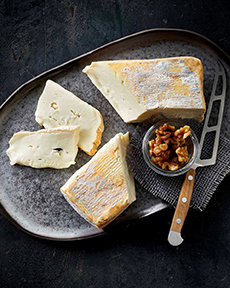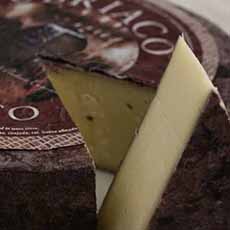PRODUCT: Ubriaco Al Birra, Ubriaco Al Vino ~ Cheeses Bathed In Beer & Wine
|
Ubriaco literally means “drunken” in Italian. It is a sub-category of washed-rind cheeses that are bathed in alcohol. Ubriaco cheeses are made by bathing the young, ripening cheese in beer (photo #2), wine (photo #3) or other alcohol, which seeps through the rind and adds complex aromas and flavors to the cheese. The alcohol used is local to the region, e.g., the prosecco ubriaco made by Moro Latteria di Moro Sergio, Veneto, Italy, and also makes an ubriaco al birra with a friend’s red ale microbrew. And ubriaco cheeses are not limited to Italy. France and Spain, among others, make their fair share, although they may simply be called washed-rind cheeses. You have to ask your cheesemaker what the wash comprises. The original washed rind cheeses that were bathed in salt water (brine). Just a few examples are Morbier, Raclette, Taleggio and Tête de Moine. Cheeses were washed with brine to keep them fresh. Like salt, beer and wine also have preservative qualities. The practice of bathing or washing a ripening cheese in beer, wine, brandy, etc. dates to medieval times, when monks experimented with alcohol baths. What made them decide to try alcohol, when a brine wash made such excellent cheeses? Perhaps there was an excess in wine production that year, which would account for using valuable wine on the cheeses. Or maybe a wheel of cheese accidentally fell into a barrel of beer or wine, to be discovered later. The monks began to realize that the alcoholic beverages made the cheeses more flavorful. These “drunken” cheeses soon became popular. The cheeses were bathed in gallons of beer or wine. the latter along with skins, seeds and other leftovers from the winemaking process. With wine, the finished wine ready-to-bottle was not used. Rather the must of the wine was used. Must is the freshly crushed grape juice that contains the skins, seeds, and stems of the fruit; plus leftovers from the wine-making process. Another technique was brushing the cheeses with the alcohol as it aged on shelves. This is a much more labor intensive technique, but preferred by some cheesemakers. Wine-washed cheeses are typically immersed or brushed for about two months, up to a year, and then aged. Other alcohols were used, too. For example: For your next cheese adventure, try a couple of ubriacos and look for the malty notes of the beer bath, the fruity, winey notes of the wine, or the deeper fruit and alcohol notes of brandy or eau de vie. Serve red wine-washed cheeses with dried figs and spiced nuts. Serve white wine-washed cheeses with dried apricots, apples or pears, cashews or hazelnuts. Serve beer-washed cheeses with grapes and sweet and/or buffalo peanuts. ANd don’t forget that glass of beer, wine, cognac or eau-de-vie. |
|
|






